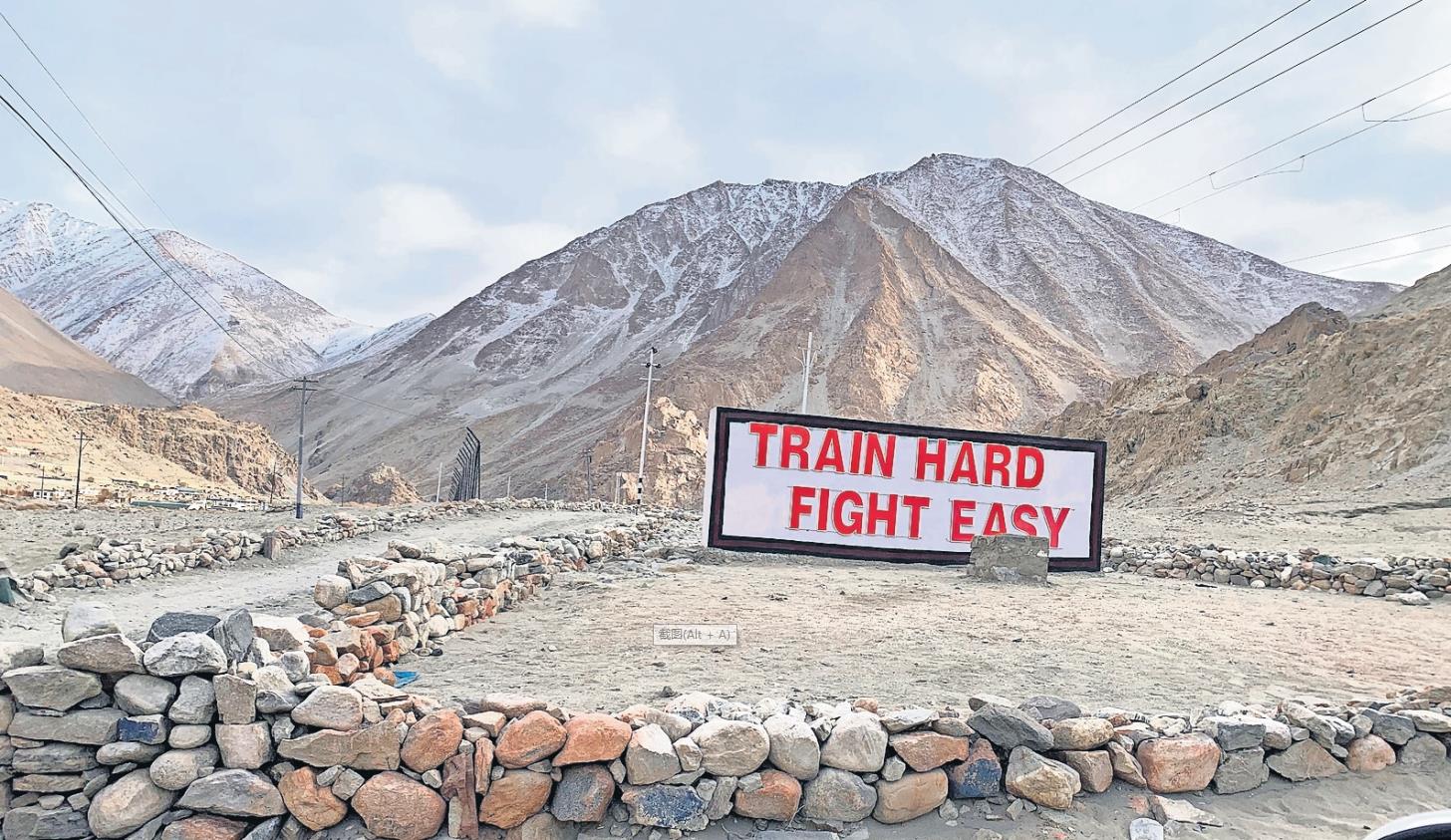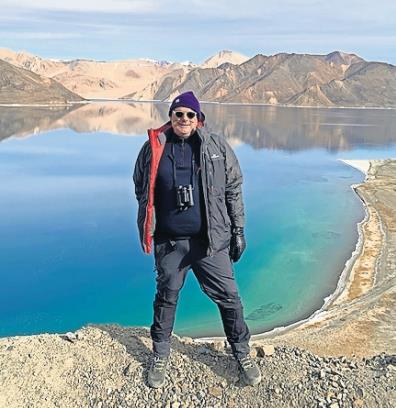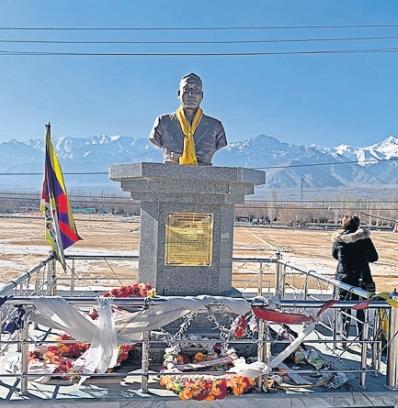Last Updated:2023-02-10

It was minus 15 degrees as the longnight was ending, when we set outfrom the ancient Silk Road logist-ics and market hub of Leh, inIndia’s northern Ladakh province.Ahead was a nine-hour returnjourney to the edge of military con-ict between India and China.
The Ladakh/Tibet area is one of the mostheavily militarised regions along the entireIndia-China border. The presence of therespective armies has been ramped up con-siderably since June 2020, when a meleeoccurred in the Gwadar Valley near LakePangong, resulting in some 20 Indian deathsand four Chinese, according to each side’sofcial statements. Global attention hassince been directed to this most remote,high-altitude region as where a Sino-Indianwar would start.
Despite the challenges of getting there,and the high altitude and extreme cold, itseemed to be worth taking a rst-hand lookat this potential ashpoint while on a visit toLadakh last month. Tensions remain high.My guide and others with whom I spoke feltit was only a matter of time before warbetween China and India breaks out there.
The region is in the high Himalaya. LakePangong is at 4524 metres, well above theheight when breathing becomes difcult. Ofits 110 kilometres, 40 are controlled by Indiaand the rest by China along the Line ofActual Control. On the northern and easternshore is China’s Tibetan AutonomousRegion. The 2020 ghting was the most seri-ous since the end of the 1962 Sino-IndianWar. An agreement between the two gov-ernments not to use rearms held. Instead,heads were smashed in by rocks and ironbars, or soldiers hurled over the vertiginous narrow ledges.
A truce was quickly reached, and anuneasy calm restored. Although on bothsides the circumstances remain largelyobscure, the Modi government was quick topublicise the events and whip up popularnationalist sentiment against China. Thishas been successful politically for Modi; thegovernment’s support has risen and Indianperceptions of China’s trustworthiness haveplummeted. Most foreign commentators,without knowing the facts, reexively tookIndia’s side against China.

It has also been costly for China geopoliti-cally. Within weeks of the skirmishes, Indiastrengthened its commitment to the Quad –the diplomatic network with Australia,Japan and the United States – and welcomedAustralia into the Malabar naval exercises,something India had resisted for years.
Then on August 30, 2020, ghting againared when India conducted a ‘ pre-emptiveoperation’ against the People’s LiberationArmy on the south bank of Lake Pangong. Inwhat threatened to escalate into a full-scaleretaliation, an Indian Army ofcer ofTibetan ethnicity, Nyima Tenzing, waskilled, provoking public outrage across thecountry. After nine rounds of negotiations, asettlement between the two sides was nallyreached in February 2021.
Along the road from Leh to Lake Pangong,a new memorial has been erected outsidethe ancient Buddhist centre of Shey, honour-ing the fallen Tenzing. Part of the eulogy sayshis ‘ act of unprecedented valour strength-ened India’s position vis-a-vis China’ .
It is probably no accident Tenzing’smemorial bust has been placed next to thereligious parade ground where in July eachyear, the Da Lai Lama comes to celebrate hisbirthday and bless thousands of followers.Ladakh is as Tibetan as Tibet itself. Tenzinghas now become an Indian-Tibetan ‘ martyr’for resisting ‘ communist China’s aggression’ .

The distance from Leh to Lake Pangong isonly 220 kilometres, but the poor conditionof the road and trafc along it makes for fourto ve hours driving each way. Leaving Leh,the road follows the Indus River on its jour-ney along its eponymous valley from MountKailas in Tibet to the Arabian Sea. Risingfrom the valley at 3500 metres, the road fol-lows ever steeper mountainous contours in tighter bends.
Icy, narrower and increasingly rough,consisting mainly of broken rocks and scree,conditions demand the driver’s full concen-tration. Some of the more dangerous sec-tions are pot-holed tarmac. Occasionally,barriers prevent vehicles plunging downprecipitous slopes into the ever-recedin valley Foor.
The road is busy with trucks, big militarytroop transports and dilapidated but gar-ishly, and sometimes amusingly, decoratedlocal buses. Few cars are seen. Overtakingslower vehicles on blind bends seems partic-ularly popular. My companion is grippingmy arm, and I’m explaining my theory that itis Darwinian: if the drivers didn’t know whatthey were doing, they would have long agodisappeared. Still, it did feel a bit like asupreme act of faith in a theory.
At the halfway point, we reach one of thehighest sealed road passes in the world.Chang La Pass at 5353 metres is not onlyhigh, but at minus 15 degrees, despite thebrilliant sunlight, bitterly cold.
At lower altitude on the other side, we seeocks of precious pashmina sheep, tendedby isolated shepherds. A herd of black yaksmake a smudge on the horizon along theshore of a small glittering frozen lake. A longconvoy of sturdy army trucks passes in theopposite direction. Since 2020, the IndianArmy has moved some 60,000 soldiers toLake Pangong along this road. The Indiangovernment has made upgrading roadaccess to the disputed areas a priority.
All roads to the border are under the con-trol and management of the Border RoadOrganisation. Our driver complained thatroad construction was taking far too long.Inefciencies at BRO and corruption werecontributing to this as much as the harsh,unforgiving conditions.
Locals feel certainthat Beijing intendsto settle the borderon its terms.
Dotted along the road, if it could still becalled such, at giddying heights are smallcamps of three or four workers sharing asingle pitched canvas tent, huddling arounda re to keep warm and prepare food. Ourdriver said the workers were recruited fromBihar state in eastern India, which is evenpoorer than Ladakh. Although modernmachinery is used, what is supposed to be amajor strategic objective – building roads tomove soldiers and equipment quickly intimes of emergency – was being done half-heartedly.
The insouciance of the effort to build thesekey strategic arteries belies the deep sense offear about China’s ambitions among the loc-als who feel certain that Beijing intends tosettle the border on its terms by forcefullytaking territory from India.
To reach the lake, it is necessary to have apassport check and a permit, and drivethrough a military base with signs warningof severe consequences for taking photo-graphs. Prominent signs regularly extol thevirtues of bravery and persistence. One read,‘ Train hard, ght easy’ .
Near the lake, surrounded by rusted barb-wire, are signs featuring skull and cross-bones and a red warning: ‘ Danger MineeldArea’ . These are relics from the 1962 China-India War. It is likely that this has been left asa monument of sorts, as it seems improb-able the area would not have long ago beencleared of mines – but this was one hypo-thesis that did not seem to be worth testing.
Lake Pangong is a magnicent stretch ofwater. Famous for its luminous variegatedshades of turquoise, a sacred colour inTibetan Buddhism. The colour derives fromcopper-sulphate, and so the lake is alsosaline. It is an endorheic basin which retainsits water and doesn’t allow an out flow.
Little military presence was apparent onthe Indian side; one can only guess about theChinese side. Only a few tourist facilities,closed for winter, were scattered around itsshore, and no activity on the water.
Tensions remain elevated and mutualsuspicions run deep. As India continuesgradually to expand its transport infrastruc-ture on its side of the LAC, so China will per-ceive the strategic balance to be changingagainst it. Whichever side started the 2020skirmishes, they have been most costly forChina in terms of a decisive shift in Indiansentiment against it, and India’s geopoliticalstance drawing closer to the US.
Meanwhile, Beijing is resetting its interna-tional relations after the counterproductiveexercises in assertive diplomacy of recentyears. But India’s massing of forces in the areasince 2020 also would mean that isolatedmelees could quickly escalate to full-scalewar. Yet as both sides have done rather wellsince 1962, the sounds of battle are unlikely tobe heard ringing through the precipitous val-leys of the high-Himalaya. But the risks ofaccident and miscalculation are extreme.
Gazing at the wide and long expanse ofwater, it seemed to disappear into innity. Atthis remote, gorgeous, peaceful place it wasimpossible to imagine that it is on a hair trig-ger for conict between two nuclearpowers.





